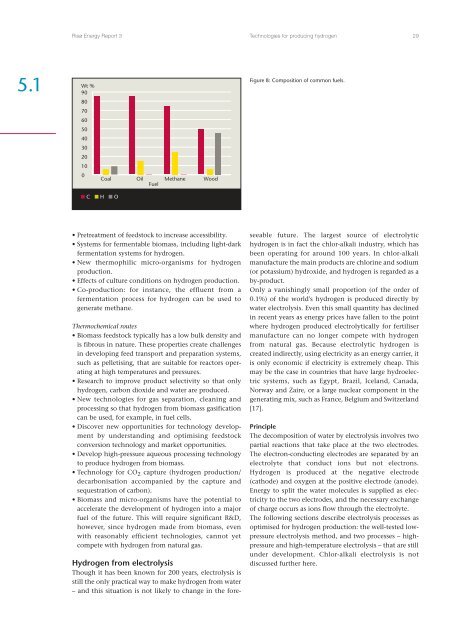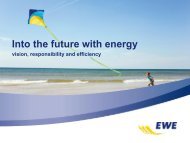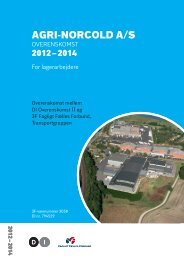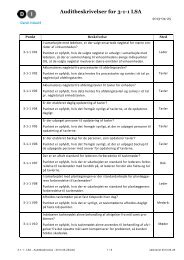Hydrogen and its competitors, 2004
Hydrogen and its competitors, 2004
Hydrogen and its competitors, 2004
You also want an ePaper? Increase the reach of your titles
YUMPU automatically turns print PDFs into web optimized ePapers that Google loves.
Risø Energy Report 3Technologies for producing hydrogen 295.1Wt %90Figure 8: Composition of common fuels.80706050403020100CoalOilFuelMethaneWood■ C ■ H ■ O• Pretreatment of feedstock to increase accessibility.• Systems for fermentable biomass, including light-darkfermentation systems for hydrogen.• New thermophilic micro-organisms for hydrogenproduction.• Effects of culture conditions on hydrogen production.• Co-production: for instance, the effluent from afermentation process for hydrogen can be used togenerate methane.Thermochemical routes• Biomass feedstock typically has a low bulk density <strong>and</strong>is fibrous in nature. These properties create challengesin developing feed transport <strong>and</strong> preparation systems,such as pelletising, that are suitable for reactors operatingat high temperatures <strong>and</strong> pressures.• Research to improve product selectivity so that onlyhydrogen, carbon dioxide <strong>and</strong> water are produced.• New technologies for gas separation, cleaning <strong>and</strong>processing so that hydrogen from biomass gasificationcan be used, for example, in fuel cells.• Discover new opportunities for technology developmentby underst<strong>and</strong>ing <strong>and</strong> optimising feedstockconversion technology <strong>and</strong> market opportunities.• Develop high-pressure aqueous processing technologyto produce hydrogen from biomass.• Technology for CO 2 capture (hydrogen production/decarbonisation accompanied by the capture <strong>and</strong>sequestration of carbon).• Biomass <strong>and</strong> micro-organisms have the potential toaccelerate the development of hydrogen into a majorfuel of the future. This will require significant R&D,however, since hydrogen made from biomass, evenwith reasonably efficient technologies, cannot yetcompete with hydrogen from natural gas.<strong>Hydrogen</strong> from electrolysisThough it has been known for 200 years, electrolysis isstill the only practical way to make hydrogen from water– <strong>and</strong> this situation is not likely to change in the foreseeablefuture. The largest source of electrolytichydrogen is in fact the chlor-alkali industry, which hasbeen operating for around 100 years. In chlor-alkalimanufacture the main products are chlorine <strong>and</strong> sodium(or potassium) hydroxide, <strong>and</strong> hydrogen is regarded as aby-product.Only a vanishingly small proportion (of the order of0.1%) of the world's hydrogen is produced directly bywater electrolysis. Even this small quantity has declinedin recent years as energy prices have fallen to the pointwhere hydrogen produced electrolytically for fertilisermanufacture can no longer compete with hydrogenfrom natural gas. Because electrolytic hydrogen iscreated indirectly, using electricity as an energy carrier, itis only economic if electricity is extremely cheap. Thismay be the case in countries that have large hydroelectricsystems, such as Egypt, Brazil, Icel<strong>and</strong>, Canada,Norway <strong>and</strong> Zaire, or a large nuclear component in thegenerating mix, such as France, Belgium <strong>and</strong> Switzerl<strong>and</strong>[17].PrincipleThe decomposition of water by electrolysis involves twopartial reactions that take place at the two electrodes.The electron-conducting electrodes are separated by anelectrolyte that conduct ions but not electrons.<strong>Hydrogen</strong> is produced at the negative electrode(cathode) <strong>and</strong> oxygen at the positive electrode (anode).Energy to split the water molecules is supplied as electricityto the two electrodes, <strong>and</strong> the necessary exchangeof charge occurs as ions flow through the electrolyte.The following sections describe electrolysis processes asoptimised for hydrogen production: the well-tested lowpressureelectrolysis method, <strong>and</strong> two processes – highpressure<strong>and</strong> high-temperature electrolysis – that are stillunder development. Chlor-alkali electrolysis is notdiscussed further here.
















